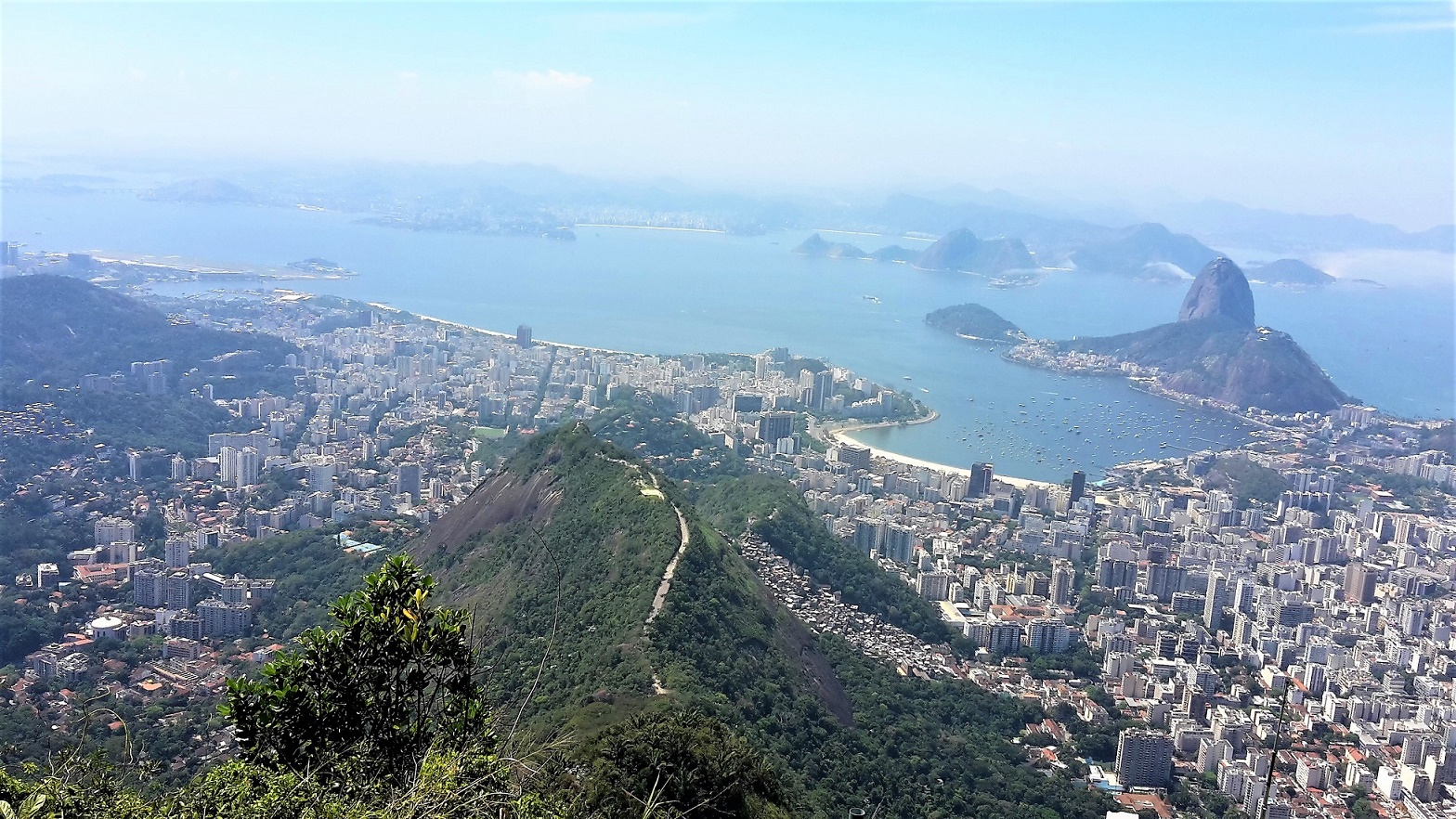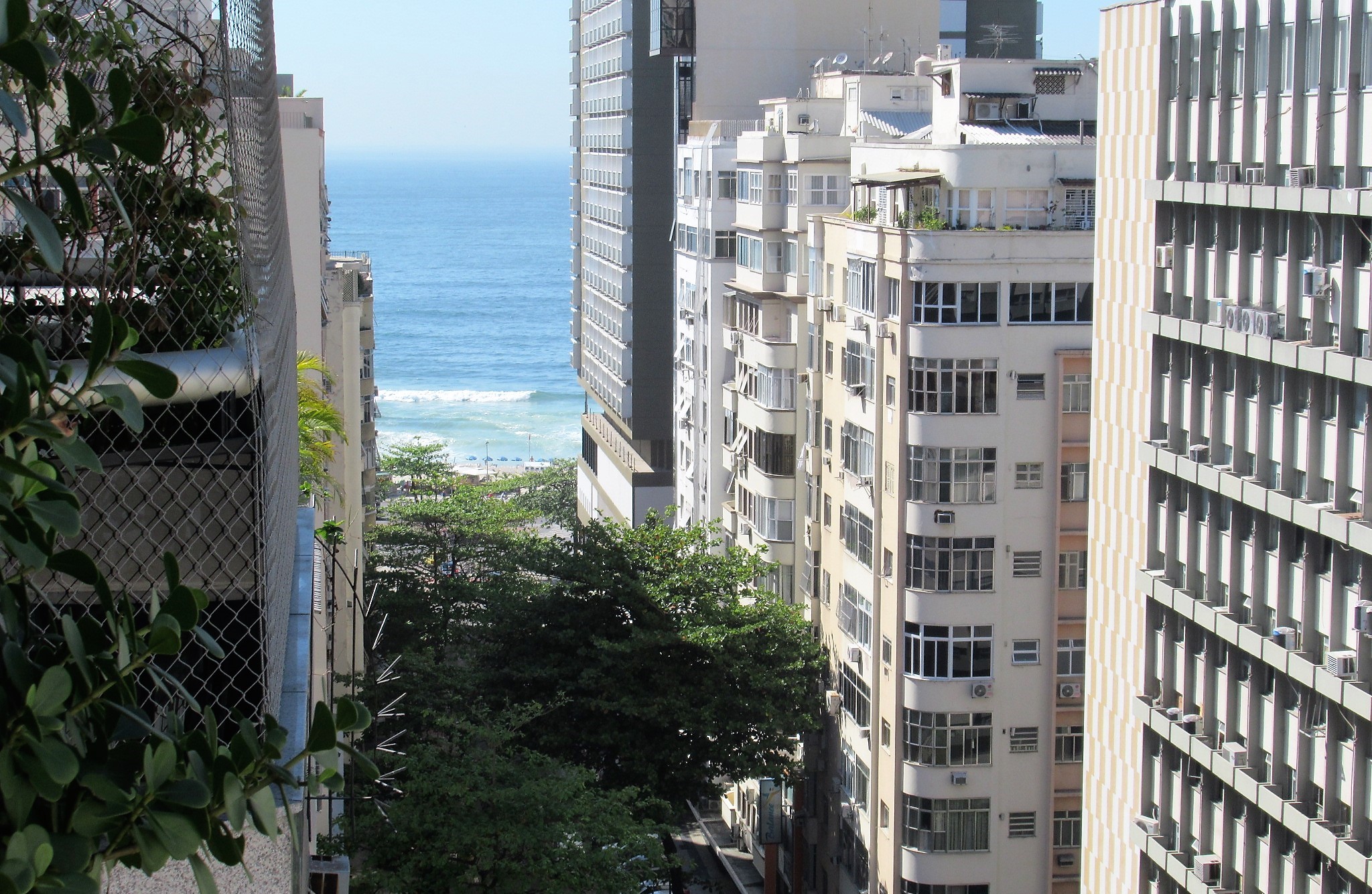Rio de Janeiro - wow what a busy and buzzy city! The second largest city in Brazil, one of its most famous, and a UNESCO World Heritage Site. We are so excited about being here.
 |
| Rio with Christ the Redeemer Statue in distance |
We arrived in Rio by bus from Belo Horizonte, then caught a taxi to our hotel. The traffic was daunting, with taxis, cars and buses everywhere. There were lots of one-way streets, narrow ones and wide ones, and others with several lanes going each way.
There were huge parks, several mountains, a lake, arresting architecture, lots of tall buildings, and many long sandy beaches.
And people – over 6 million of them just in the main city area. They were everywhere and in all sorts of shapes, sizes and colours.
Our hotel was in Copacabana. Our room had a balcony overlooking a tree-lined street, with a great view down to Copacabana beach.
That afternoon, we went for a walk down to the beach. It is bordered on one side by beautiful white sand and the Atlantic Ocean, and on the other by dozens of tall white buildings. In the middle, along all 4 kilometres of the beach length, is a wide strip of footpath full of bars and cafes - it is a very vibrant scene.
The day after arriving, we caught the very efficient Rio metro into the city centre where we spent quite a few hours just wandering around.
 |
| Busy and buzzy Rio (UNESCO) |
The area is full of commercial buildings, shops and historic monuments It is relatively compact, so we were able to walk to most of the sights.
We saw a huge range of architecture - very modern and interesting buildings, next door to art deco and historic ones. Brazil was colonised by the Portuguese in 1500, and some of the architecture still reflects elements of the colonial times.
We particularly liked the Neoclassic Tiradentes Palace and National Library, and the beautiful Art Nouveau Municipal Theatre, which looks very similar to the Paris Opera House.
 |
| Rio Cathedral |
But a highlight was the modern Rio de Janeiro Cathedral, which is a tall cone-shaped building that is very distinctive.
Built in the 60's, the unusual design was apparently inspired by the Mayan pyramids. It is 96 meters tall and its hollow interior has the most amazing stained-glass windows. It is certainly very different.
Next, we walked to the Lapa neighbourhood to find the Selarón Staircase.
 |
| Marg on the Selarón Staircase, Rio (UNESCO) |
Nearby, we saw a quaint little tram crossing an unusual bridge. We learned that the bridge is actually an historic 18th century aqueduct, built to carry fresh water into the city. Officially called the Carioca Aqueduct, it is also known as the Arcos da Lapa (Lapa Arches), and now serves as a bridge for the Santa Teresa Tramway.
 |
| Carioca Aqueduct with wee tram up to Santa Teresa, Rio (UNESCO) |
The tram connects the city centre with the old, once-fashionable residential neighbourhood of Santa Teresa.
We took the tram up there, and at the top, we found that many of the once-beautiful grand homes of Santa Teresa, are now run-down, and some are covered with graffiti and street art.
However, its narrow winding cobbled streets, great views, and grand buildings give it a uniqueness that have made Santa Teresa home to many of the city's artists and galleries.
 |
| Beautiful Rio viewed from waterfront area |
Working our way north, we came to Rio’s waterfront area. There we saw more grand buildings, including some impressive looking churches.
While at the waterfront, we found a little seafood restaurant where we lunched on Vatapá, a spicy prawn dish that is a specialty of Brazil. The lovely waitress enlisted the help of a nearby young man to translate for us, and was very pleased with herself for doing so - and so were we - the meal was absolutely delicious!
 |
| Christ the Redeemer statue, Rio (UNESCO) |
The wee train travelled up an incredibly steep track through the Tijuca National Park. We then had to climb 223 steps to the base of the statue (we didn’t see the elevators until we were on the way down!).
The statue itself, is 39.6 metres high and can be seen from all over Rio.
 |
| View of Rio from Christ the Redeemer statue |
The view from the top was spectacular. We ferreted our way through the massively huge throng of tourists, to be rewarded with a 360-degree vista over Rio and its beaches. It was stunning.
Mission completed and with lots of photos, we came back down the hill, and caught a bus to the interesting neighbourhood of Largo do Machado.
After a wee look around there, we walked to Flamengo Beach. This is another beautiful white sandy beach.
Pretty hot by now, we walked further around the coast to Botafogo to find somewhere for lunch and to cool down.
Botafogo is a lovely seaside area, and known as an upper-class neighbourhood. It seemed to have plenty of restaurants and museums, as well as nice housing.
 |
| Urca & Sugarloaf Mountain seen from Botafogo, Rio (UNESCO) |
From Botafogo, we could see Sugarloaf Mountain. So, refreshed after lunch, we figured it was a longish but doable walk to Urca, and the base of the famous mountain.
We followed our map, and a few kilometres later we were there. Wanting to see more, we caught an interesting capsule-like funicular to the top of Sugarloaf.
We were quite chuffed at getting a half price fare for being over 60 :-)
 |
| Funicular up Sugarloaf Mountain, Rio (UNESCO) |
The views there were even better, with another superb vista over Rio and its surrounds. But this time we were able to see a quite different part of the city. It was definitely worth the walk there from Botafogo.
Back down via the funicular and another walk, found us at a bus stop with a bus just leaving for Copacabana. We caught it just in time to take us, with our tired feet, back to our hotel.
After a day or two of rest, reading and beach-watching, we caught a bus to the end of Ipanema Beach, which is the next beach along from Copacabana.
 |
| Marg on Ipanema Beach, Rio (UNESCO) |
We decided it was more upmarket than Copacabana, with classier apartments and shops.
We were there on a Sunday, and the beach-side road was closed to motor vehicles so that the locals could access it by foot, bicycle, roller blades, skate boards and the like - and they did - lots and lots of them.
From Ipanema though, and in direct contrast to the evident wealth of the area, we saw one of the favelas (slums) that Rio has become known for.
This was up on the hillside above us.
We had decided not to do one of the many favela tours on offer, as we could not be sure that the money we paid for the tour would go to the people in the favela. Besides that, we feel that it is like a human zoo, where the privacy and dignity of the residents is compromised.
Leaving Ipanema, we eventually, worked our way back to Copacabana beach toward home.
By this time it was sunset, and we found hundreds of stalls set up along the roadside to catch the evening beach-goers; of which there were many. The stallholders were selling a huge range of goods, and we both bought a “Rio” t-shirt.
We loved our stay in Rio de Janeiro and thought it was a great city. The people were friendly and very helpful to us, and we felt very safe walking around the city beaches and the city centre.
Now it’s time to force the suitcases shut again and head on to our next stop, Ilha Grande.





Thanks for sharing your lovely photos of beautiful Rio. Always wanted to spend a month or so there. And now maybe I will. :-)
ReplyDelete